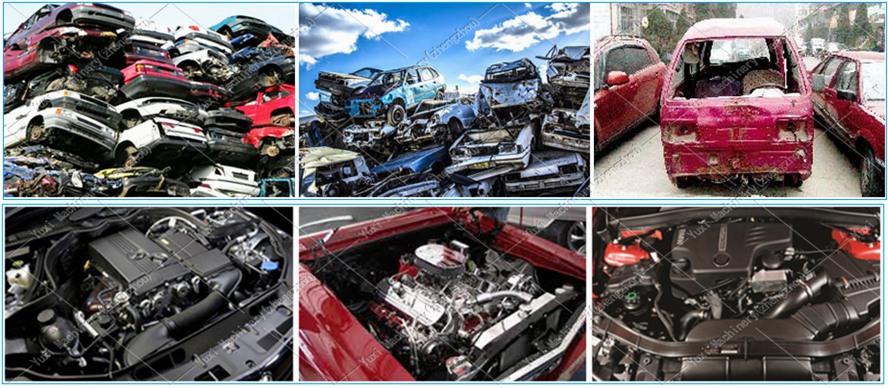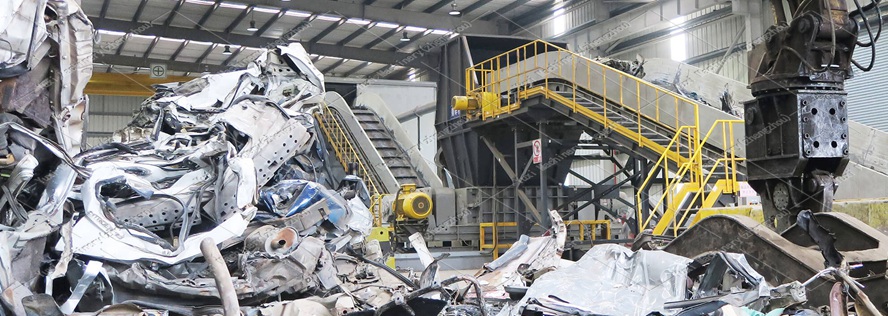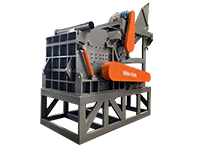In the current context of global resource scarcity and increasing environmental awareness, the recycling of scrap cars has become a key area for achieving sustainable development. The scrap car shredder, as a core equipment in this field, is not only an "industrial tool" for dismantling scrap cars, but also an important force for promoting resource circulation and practicing green development. It enables every material to be revitalized through precise crushing and classified recycling of various parts of scrap cars, while building a solid defense for environmental protection.

Component Adaptation: The "Precision Crushing Philosophy" of Scrap Car Shredders
Scrap cars are composed of parts made of various materials such as metal, plastic, rubber, and fiber. Different parts have very different performance requirements for shredders, which requires scrap car shredders to have the ability of "adapting to different parts" for precise crushing.
1.Bumper and dashboard as an example
Take bumpers and instrument panels as examples. These parts are mostly made of reinforced engineering plastics such as ABS and PPO, and glass fibers are added to enhance their strength. A special shredder introduced by an automobile recycling industrial park is equipped with high-wear-resistant alloy cutters and a special structural crushing chamber, with a motor power of 150 horsepower. It effectively copes with the high wear challenge brought by glass fibers, so that the materials after bumper crushing can be directly used in the remanufacturing of auto parts, saving the park more than ten million yuan in raw material costs every year.
2.Steering wheels, door interior panels and other elastic parts
For elastic parts such as steering wheels and door interior panels, their materials are mostly PU and EPDM rubber, which have strong elasticity and deformation ability. Ordinary shredders are prone to problems such as knife sticking and uneven cutting. In the production workshop of an environmental protection enterprise in the Yangtze River Delta, a shredder optimized for soft elastic materials has become a "star equipment" - by adjusting the angle of the cutters and adding a cooling system, the motor power is configured to 120 horsepower, which perfectly solves the crushing problem of elastic materials. The recycling rate of door interior panels is increased to 98%, and the crushed materials are made into new seals, which are widely used in the home appliance industry.
3.Smashing of car headlights
The crushing of automobile lamps has extremely high requirements for cleanliness, because they are mostly made of transparent materials such as PC and PMMA. Once dust is mixed in, it will cause the recycled products to turn yellow and have black spots. The solution of a leading automobile dismantling enterprise in the Pearl River Delta is quite representative: a high-efficiency dust removal device is installed at the rear end of the shredder, which can remove more than 95% of the dust, and the motor power is 80 horsepower, ensuring that the purity of the crushed transparent particles is close to that of the raw materials. These particles are sent to optical material factories and transformed into optical components for mobile phone screens, realizing a high-value cycle.
4.Crushing of car tires
The crushing of automobile tires is a more systematic project. A tire crushing production line developed by a machinery enterprise in Chicago can process the entire tire through processes such as coarse crushing, steel wire separation, fine crushing, and fiber separation in sequence, and finally obtain pure rubber particles. The total motor power of this production line is 500 horsepower. These particles are used to pave urban greenways and school playgrounds. In the "green road" construction of a certain North American city, the rubber particles provided by this production line make dozens of kilometers of greenways both non-slip and durable, becoming an environmental protection business card of the city, and at the same time, realizing a closed-loop utilization of rubber resources.

Frequently Asked Questions
Q: How is the environmental performance of scrap car shredders guaranteed?
A: Modern scrap car shredders are generally equipped with dust removal and noise reduction devices. The dust removal system can efficiently capture the dust generated during the crushing process, and the dust emission is controlled below 0.1 g/m³ to avoid air pollution; some equipment adopts sound insulation design, and the noise is controlled within 85 decibels. More importantly, its core value lies in reducing waste landfilling and incineration through material recycling, practicing environmental protection from the source.
Q: What are the core points to pay attention to when investing in scrap car shredders?
A: It is necessary to select equipment with matching production capacity according to its own scrap car recycling scale; priority should be given to manufacturers with mature technology and good reputation to ensure equipment durability and after-sales service; at the same time, attention should be paid to local policies, such as scrap car recycling subsidies and market demand for recycled materials, to ensure investment returns and long-term operations. In addition, the equipment must meet ASTM material standards to ensure the market circulation of crushed materials.
Q: What factors affect the crushing effect of scrap car shredders?
A: It is mainly affected by equipment selection, cutter wear, and operational standardization. It is necessary to select the right equipment according to the material of the parts, regularly maintain and replace the cutters, and the operators need to undergo professional training to strictly control the feeding speed and uniformity, and ensure that the particle size deviation of the crushed material is controlled within ±2 mm, so as to ensure a stable and efficient crushing effect.
The scrap car shredder is by no means a simple "industrial crusher", but a "converter" for resource circulation and green development. It transforms scrap cars from an "environmental burden" into a "treasure trove of resources", practicing the concept of sustainable development in every precise crushing. With the continuous iteration of technology, the future scrap car shredders will be more intelligent and efficient, the motor energy efficiency will be upgraded to IE5 level, and the environmental emission standards will be further tightened, contributing more to the global resource circulation and environmental protection cause, and making the vision of "green manufacturing" and "circular economy" take root in industrial production.
 Shredding Machine
Shredding Machine
 Waste Recycling Line
Waste Recycling Line
 Optional Equipment
Optional Equipment


